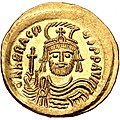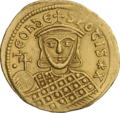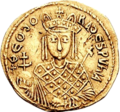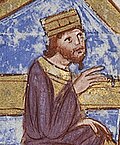| Portrait | Name | Reign | Dynasty | Comments and notes |
|---|
|
 | Maurice | 582–602
(20 years) | Justinian | Medieval Armenian chroniclers such as Stepanos Taronetsi and Kirakos Gandzaketsi claim Maurice to be of Armenian origin. [24] A 7th century obelisk in Oshakan, Armenia is attributed by a local tradition to Maurice or his mother. [4] [5] [6] Modern scholarship, however, does not have a consensus. Krzysztof Stopka writes that it is generally regarded as a legend. [25] It has been accepted by Nicholas Adontz, [26] Peter Charanis, [a] Henri Grégoire, [12] Robert H. Hewsen, [14] but rejected by others, such as Paul Goubert. [28] Walter Kaegi described him as "of probable Armenian origin." [29] Anthony Kaldellis argues that his Armenian ancestry is "largely unknown to historians who study his reign" and that "no contemporary source—and there are many— mentions it." He considers the medieval Armenian chronicles to be "Armenian folktales" and notes that "[n]one of the names in his extended family are Armenian". A. E. Redgate is also skeptical; as the "counter-arguments, in his case, seem overwhelming." [31] |
 | Heraclius | 610–641
(31 years) | Heraclian | The son of Heraclius the Elder, who is generally recognized by scholars as an Armenian. [39] [b] According to the 7th century Armenian historian Sebeos, Heraclius was related to the Arsacid dynasty of Armenia. [41] Hewsen talked of the Heraclids being "of royal Arsacid origin." [14] Redgate considers his Armenian origin likely. [31] Walter Kaegi notes that Heraclius was presumably "bilingual (Armenian and Greek) from an early age, but even this is uncertain." [32] Kaldellis argues that his Armenian origin "takes the prize for fiction masquerading as history" and that statements regarding his ancestry "have been woven out of thin air". He notes that "there is not a single primary source that says that Herakleios was an Armenian" and, moreover, "none of the names in his extended family are Armenian, and this in an age when Armenian generals in Roman service kept their native names and did not always switch to Graeco-Roman ones". He writes that this assertion about Heraclius' ancestry is based on an erroneous reading of Theophylact Simocatta. In a letter, Priscus, a general who had replaced Heraclius the Elder, wrote to him "to leave the army and return to his own city in Armenia". Kaldellis interprets it as the command headquarters of Heraclius the Elder, and not his home town, since "[i]t would make no sense in the context of the narrative for Philippikos to send Herakleios “home.”". According to historian Benjamin Anderson, Kaldellis "effectively debunks the received wisdom" on Heraclius's origins. [44] |
 | Mizizios | 668–669
(1 year) | | Considered Armenian by mainstream scholarship. [45] [46] [47] He came from the Gnuni family. |
 | Philippicus
Bardanes | 711–713
(2 years) | | Considered Armenian by mainstream scholarship. [c] [53] Kaldellis disputes this view, pointing to his anti-Armenian policies such as his decision to expel all Armenians from the empire, forcing them to seek refuge among the Arabs, (though this wasn't fully enforced) and his later decree ordering all Armenians to accept the authority of the Patriarch of Constantinople. According to Kaldellis, this "shows that despite his ancestry he was not, and did not consider himself to be, 'an Armenian,' as some modern historians call him" and speculated that he may have been Persian. |
 | Artabasdos | 741–743
(2 years) | | Considered Armenian by mainstream scholarship. [55] [56] [14] Nina Garsoïan suggests that he hailed from the Mamikonian house. [57] Kaldellis believes that we "do not know enough about the first [i.e. Artabasdos] to have an interesting discussion of his ethnicity." |
 | Leo V | 813–820
(7 years) | non-dynastic | Scholars agree that he was at least partly of Armenian origin. [d] [65] According to Jenkins, was certainly of Armenian stock on one side. He is said to have been 'Assyrian', that is, Syrian, on the other: but this is perhaps attached to him owing to his heretical and iconoclastic beliefs, and to the fact that he modelled himself on the great iconoclast conqueror Leo III, to whom Syrian descent was more certainly attributed. [66] He is the only emperor to be nicknamed "Armenian" by Byzantine historians. [1] Armenian chronicles claimed he was an Artsruni. [67] Kaldellis notes that his "ancestry is said to have been Armenian, Assyrian, and Amalekite (a biblical ethnonym), whatever exactly those terms may have meant in a late eighth-century context." He also writes that "we have no evidence for how Leon V acknowledged, tried to hide or counter, or ameliorated his “ethnic” background as emperor". |
 | Constantine | 813–820
(7 years) | co-emperor
non-dynastic | The son of Leo V the Armenian. |
 | Michael III | 842–867
(25 years) | Amorian | His mother, Theodora, the wife of Theophilos, is considered by some scholars to have been, at least partly, of Armenian origin. [70] [e] Kaldellis argues that "As the restorer of icons in 843, many texts discuss her, yet none refers to her Armenian ethnicity." |
 | Theodora | 842–856
(14 years) | Amorian | Empress regnant during the minority of Michael III. [72] [73] Considered by some scholars to have been, at least partly, of Armenian origin. [76] [f] Kaldellis wrote that no source (Byzantine or Medieval Armenian) refers to her as an Armenian, or as being of Armenian descent. |
|
| Portrait | Name | Reign | Dynasty | Comments and notes |
|---|
 | Basil I | 867–886
(19 years) | Macedonian | His father is considered by many to be of Armenian origin. [84] The Armenian descent of his mother is debated. [g] [86] Her name, which is Greek, points to a Greek origin for her. [87] [88] Medieval Armenian historians Samuel Anetsi and Stepanos Taronetsi claimed that he hailed from the region of Taron. He is also "presumed to have descended from the kingly house of the Arsacids." [62] Kaldellis calls the Arsacid connection "propaganda", aimed to confer legitimacy upon Basil's alleged "royal" and "biblical" origins [h] and additionally meant to give "diplomatic leverage in his dealings with the empire’s Armenian neighbors". He wrote: "The Romans generally called Basileios a Macedonian, from his provincial origin, rather than an Armenian, and some Arabic texts call him a Slav. [i] Warren Treadgold wrote that his Arsacid origin is an "obvious forgery", but he "may have had Armenian blood." [92] |
 | Romanos I
Lekapenos | 920–944
(24 years) | Macedonian/
Lekapenos | According to some scholars. [61] [63] [93] Charanis wrote that Romanos Lekapenos was "definitely known to have been of Armenian origin." According to Mark Whittow Romanos "seem[s] to have been Armenian." [63] According to Kaldellis, Romanos is discussed in many Byzantine sources, "but none of them calls him an Armenian," but because his father came from humble origin he was assumed to have been Armenian. "His alleged ethnicity has been repeated so often in the literature that it has acquired the status of a known fact, even though it is based on the most tenuous of indirect connections," wrote Kaldellis. |
 | Nikephoros II
Phokas | 963–969
(9 years) | Macedonian | According to some scholars he was of at least partial Armenian descent. [35] [j] Kaldellis notes that recent scholarship has correctly removed his family's name from the list of Byzantine families of "Armenian" origin, writing that it had been placed there originally for "flimsy (i.e., nonexistent) reasons". |
 | John I
Tzimiskes | 969–976
(8 years) | Macedonian | Considered Armenian by mainstream scholarship. [98] [k] According to the medieval Armenian chronicler Matthew of Edessa Tzimiskes was from the region of Khozan, from the area which is now called Chmushkatzag." [100] Kaldellis is skeptical, calling the grounds for his Armenian origin "extremely weak", noting that "Tzimiskes" was a nickname given to him by Armenian soldiers serving under him, referring to his short statute, and not a family name. Evaluating the evidence, he concludes that "No ethnicity or even distant ancestry can be proposed based on such evidence". |
|
 | Andronikos III
Palaiologos | 1328–1341
(13 years) | Palaiologos | His mother, Rita-Maria, was the daughter of Leo II, King of Armenian Cilicia, and sister of Hethum II. [103] [104] [105] |
|
















